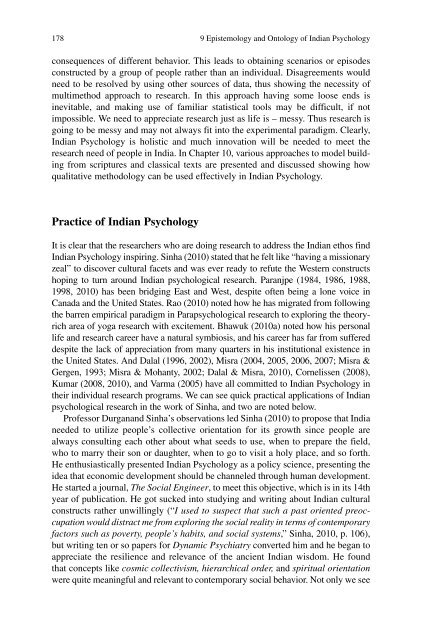Spirituality and Indian Psychology: Lessons from ... - Mandhata Global
Spirituality and Indian Psychology: Lessons from ... - Mandhata Global
Spirituality and Indian Psychology: Lessons from ... - Mandhata Global
You also want an ePaper? Increase the reach of your titles
YUMPU automatically turns print PDFs into web optimized ePapers that Google loves.
178 9 Epistemology <strong>and</strong> Ontology of <strong>Indian</strong> <strong>Psychology</strong><br />
consequences of different behavior. This leads to obtaining scenarios or episodes<br />
constructed by a group of people rather than an individual. Disagreements would<br />
need to be resolved by using other sources of data, thus showing the necessity of<br />
multimethod approach to research. In this approach having some loose ends is<br />
inevitable, <strong>and</strong> making use of familiar statistical tools may be difficult, if not<br />
impossible. We need to appreciate research just as life is – messy. Thus research is<br />
going to be messy <strong>and</strong> may not always fit into the experimental paradigm. Clearly,<br />
<strong>Indian</strong> <strong>Psychology</strong> is holistic <strong>and</strong> much innovation will be needed to meet the<br />
research need of people in India. In Chapter 10, various approaches to model building<br />
<strong>from</strong> scriptures <strong>and</strong> classical texts are presented <strong>and</strong> discussed showing how<br />
qualitative methodology can be used effectively in <strong>Indian</strong> <strong>Psychology</strong>.<br />
Practice of <strong>Indian</strong> <strong>Psychology</strong><br />
It is clear that the researchers who are doing research to address the <strong>Indian</strong> ethos find<br />
<strong>Indian</strong> <strong>Psychology</strong> inspiring. Sinha (2010) stated that he felt like “having a missionary<br />
zeal” to discover cultural facets <strong>and</strong> was ever ready to refute the Western constructs<br />
hoping to turn around <strong>Indian</strong> psychological research. Paranjpe (1984, 1986, 1988,<br />
1998, 2010) has been bridging East <strong>and</strong> West, despite often being a lone voice in<br />
Canada <strong>and</strong> the United States. Rao (2010) noted how he has migrated <strong>from</strong> following<br />
the barren empirical paradigm in Parapsychological research to exploring the theoryrich<br />
area of yoga research with excitement. Bhawuk (2010a) noted how his personal<br />
life <strong>and</strong> research career have a natural symbiosis, <strong>and</strong> his career has far <strong>from</strong> suffered<br />
despite the lack of appreciation <strong>from</strong> many quarters in his institutional existence in<br />
the United States. And Dalal (1996, 2002), Misra (2004, 2005, 2006, 2007; Misra &<br />
Gergen, 1993; Misra & Mohanty, 2002; Dalal & Misra, 2010), Cornelissen (2008),<br />
Kumar (2008, 2010), <strong>and</strong> Varma (2005) have all committed to <strong>Indian</strong> <strong>Psychology</strong> in<br />
their individual research programs. We can see quick practical applications of <strong>Indian</strong><br />
psychological research in the work of Sinha, <strong>and</strong> two are noted below.<br />
Professor Durgan<strong>and</strong> Sinha’s observations led Sinha (2010) to propose that India<br />
needed to utilize people’s collective orientation for its growth since people are<br />
always consulting each other about what seeds to use, when to prepare the field,<br />
who to marry their son or daughter, when to go to visit a holy place, <strong>and</strong> so forth.<br />
He enthusiastically presented <strong>Indian</strong> <strong>Psychology</strong> as a policy science, presenting the<br />
idea that economic development should be channeled through human development.<br />
He started a journal, The Social Engineer, to meet this objective, which is in its 14th<br />
year of publication. He got sucked into studying <strong>and</strong> writing about <strong>Indian</strong> cultural<br />
constructs rather unwillingly (“I used to suspect that such a past oriented preoccupation<br />
would distract me <strong>from</strong> exploring the social reality in terms of contemporary<br />
factors such as poverty, people’s habits, <strong>and</strong> social systems,” Sinha, 2010, p. 106),<br />
but writing ten or so papers for Dynamic Psychiatry converted him <strong>and</strong> he began to<br />
appreciate the resilience <strong>and</strong> relevance of the ancient <strong>Indian</strong> wisdom. He found<br />
that concepts like cosmic collectivism, hierarchical order, <strong>and</strong> spiritual orientation<br />
were quite meaningful <strong>and</strong> relevant to contemporary social behavior. Not only we see

















